-
 New product UsedShimano Ultegra chainring
New product UsedShimano Ultegra chainring- €83.99
-
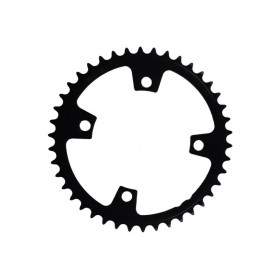 New product -34%Chainwheel FSA Powerbox ABS and SL-K ABS 10 or 11s
New product -34%Chainwheel FSA Powerbox ABS and SL-K ABS 10 or 11s- €49.49
- €74.99
-
 New product UsedChainring Specialites TA Zephyr 110 mm
New product UsedChainring Specialites TA Zephyr 110 mm- €34.99
-
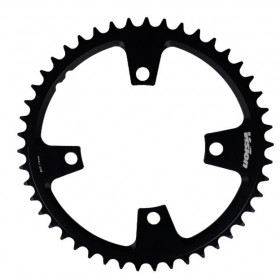 New product -35%Chainwheel 46 teeth Vision FSA Powerbox ABS and SL-K ABS 10 or 11s
New product -35%Chainwheel 46 teeth Vision FSA Powerbox ABS and SL-K ABS 10 or 11s- €26.64
- €40.99
-
 UsedShimano Dura ace chainring
UsedShimano Dura ace chainring- €44.99
-
 New productStronglight CT2 chainring 9 to 10 speed
New productStronglight CT2 chainring 9 to 10 speed- €29.99
-
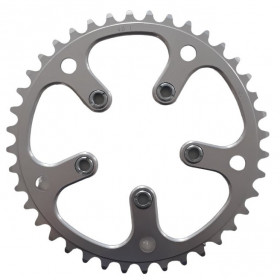 New productChainring 9s 130 mm
New productChainring 9s 130 mm- €24.99
-
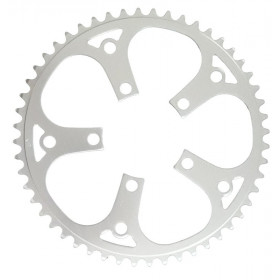 New product52 teeth chainwheel Stronglight 86 mm
New product52 teeth chainwheel Stronglight 86 mm- €19.99
-
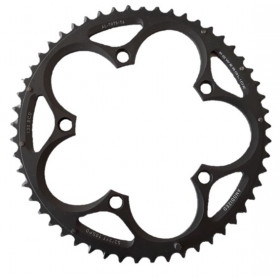 New productStronglight Powerglide 53 teeth chainring 130 mm 9/10 speed
New productStronglight Powerglide 53 teeth chainring 130 mm 9/10 speed- €15.90
-
 34 teeth chainring
34 teeth chainring- €7.99
-
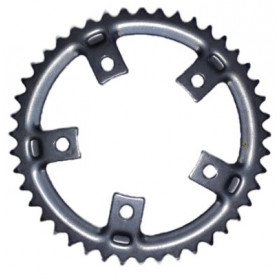 New productChainring 44 teeth 110 mm 5 to 7s
New productChainring 44 teeth 110 mm 5 to 7s- €7.99
-
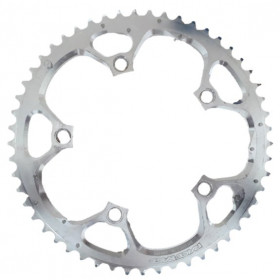 New product UsedRace Face Cadence 53 teeth chainring 130 mm 9/10 speed
New product UsedRace Face Cadence 53 teeth chainring 130 mm 9/10 speed- €24.90
-
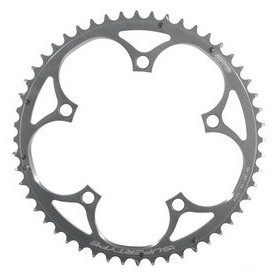 New productMiche Supertype 52 teeth chainring 130 mm 9/10 speed
New productMiche Supertype 52 teeth chainring 130 mm 9/10 speed- €24.80
-
 New product -25%Rotor noQ chainring 52 teeth 10-11 speed 110 mm
New product -25%Rotor noQ chainring 52 teeth 10-11 speed 110 mm- €67.49
- €89.99
-
 Used -30%Internal chainring Campagnolo Super record 34 teeth 12s 112 mm
Used -30%Internal chainring Campagnolo Super record 34 teeth 12s 112 mm- €65.09
- €92.99
-
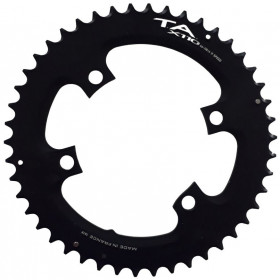 New product -30%Specialites TA X110 chainring 46 teeth 110 mm
New product -30%Specialites TA X110 chainring 46 teeth 110 mm- €54.53
- €77.90
-
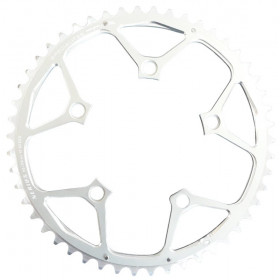 New product -50%Chainring 50 teeth 110 mm TA Nerius 8,9, 10s
New product -50%Chainring 50 teeth 110 mm TA Nerius 8,9, 10s- €35.70
- €71.40
-
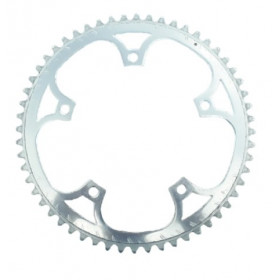 UsedStronglight chainring 53 teeth 130 mm 9v
UsedStronglight chainring 53 teeth 130 mm 9v- €6.99
-
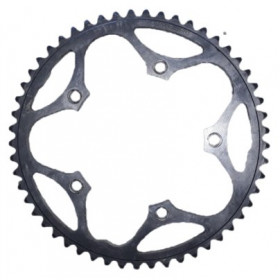 UsedStronglight chainring 53 teeth 130 mm 8 to 9 speed
UsedStronglight chainring 53 teeth 130 mm 8 to 9 speed- €7.99
-
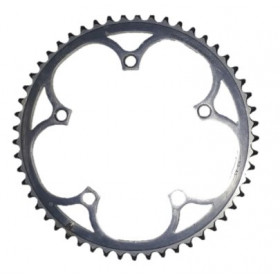 UsedCampagnolo chainring 53 teeth 135 mm 8-9 s
UsedCampagnolo chainring 53 teeth 135 mm 8-9 s- €7.99
-
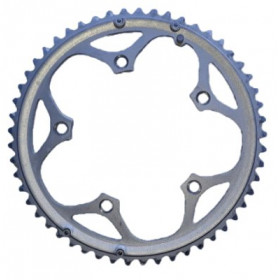 New productShimano chainring 53 teeth type A 9 speed 130 mm
New productShimano chainring 53 teeth type A 9 speed 130 mm- €14.90
-
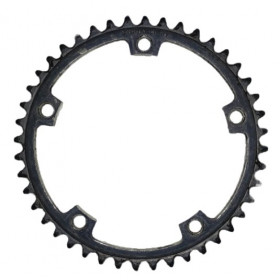 UsedStronglight chainring 44 teeth 7/8 speed 144 mm
UsedStronglight chainring 44 teeth 7/8 speed 144 mm- €4.99
-
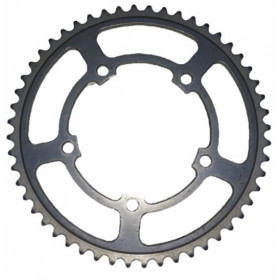 New productChainring 52 teeth 7 speed 120 mm
New productChainring 52 teeth 7 speed 120 mm- €8.99
-
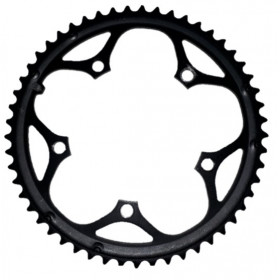 New productShimano chainring 53 teeth type B 9/10 speed 130 mm
New productShimano chainring 53 teeth type B 9/10 speed 130 mm- €14.90
-
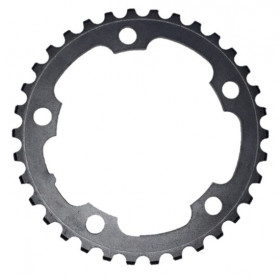 New productShimano chainring 34 teeth type F 9 speed 110 mm
New productShimano chainring 34 teeth type F 9 speed 110 mm- €7.99
-
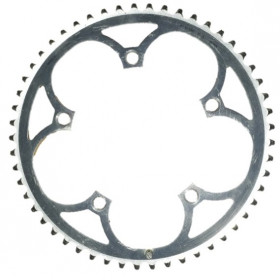 UsedSuntour Superbe PRO chainring 53 teeth 130 mm 8/9 speed
UsedSuntour Superbe PRO chainring 53 teeth 130 mm 8/9 speed- €8.99
-
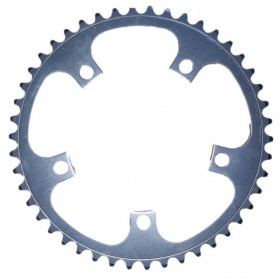 New productChainring 46 teeth aluminium 7/8 speed 120 mm
New productChainring 46 teeth aluminium 7/8 speed 120 mm- €9.99
-
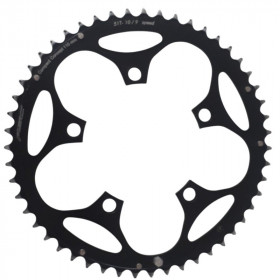 UsedChainring 51 teeth compact 110 mm 9-10 speed used
UsedChainring 51 teeth compact 110 mm 9-10 speed used- €3.99
-
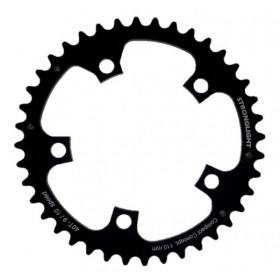 New productStronglight 40 teeth chainring compact 9/10 speed 110mm
New productStronglight 40 teeth chainring compact 9/10 speed 110mm- €15.50
-
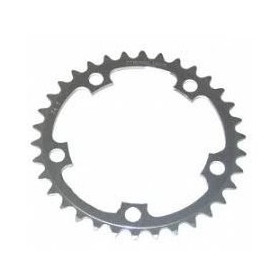 New productStronglight 40 teeth chainring compact 9/10 speed 110 mm
New productStronglight 40 teeth chainring compact 9/10 speed 110 mm- €19.90
-
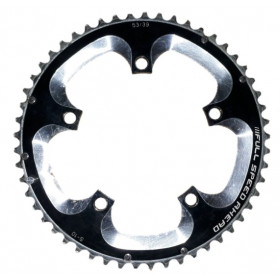 UsedFSA 53 teeth chainring 10 speed 130 mm
UsedFSA 53 teeth chainring 10 speed 130 mm- €24.90
-
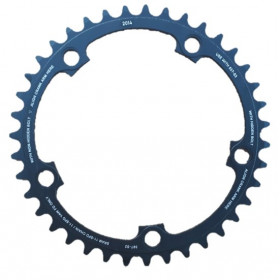 New productSram Red XGlide chainring 39 teeth 11 speed 130 mm
New productSram Red XGlide chainring 39 teeth 11 speed 130 mm- €19.90
-
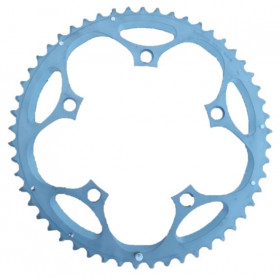 New productShimano 53 teeth chainring 9 speed type B 130 mm
New productShimano 53 teeth chainring 9 speed type B 130 mm- €9.90
-
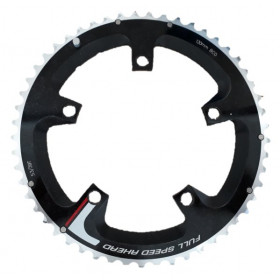 New productFSA DA-79 chainring 52 teeth 10 speed 130 mm
New productFSA DA-79 chainring 52 teeth 10 speed 130 mm- €44.90
-
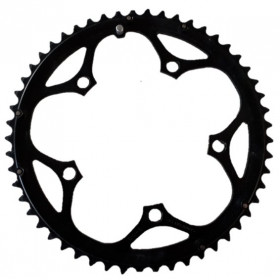 New productShimano 53 teeth chainring 9 speed 130 mm
New productShimano 53 teeth chainring 9 speed 130 mm- €9.90
-
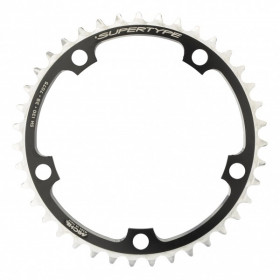 New productMiche Supertype chainring 40 teeth 135 mm 9/10 speed
New productMiche Supertype chainring 40 teeth 135 mm 9/10 speed- €24.80
-
 More detailsNew product Out-of-StockCampagnolo 53 teeth chainring 135 mm 10s
More detailsNew product Out-of-StockCampagnolo 53 teeth chainring 135 mm 10s- €14.90
-
 More detailsNew product Out-of-StockCampagnolo 50-tooth chainring 10s 110 mm alu
More detailsNew product Out-of-StockCampagnolo 50-tooth chainring 10s 110 mm alu- €14.90
-
 More detailsNew product Out-of-StockMiche pista advanced chainring 46 teeth 144 mm 1/2" x 1/8"
More detailsNew product Out-of-StockMiche pista advanced chainring 46 teeth 144 mm 1/2" x 1/8"- €44.99
-
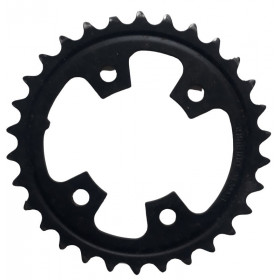 More detailsUsed Out-of-StockShimano Sora FC-R3030 chainring 30 teeth
More detailsUsed Out-of-StockShimano Sora FC-R3030 chainring 30 teeth- €2.99
-
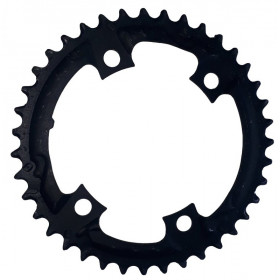 More detailsUsed Out-of-StockShimano Sora FC-R3030 chainring 39 teeth
More detailsUsed Out-of-StockShimano Sora FC-R3030 chainring 39 teeth- €3.99
-
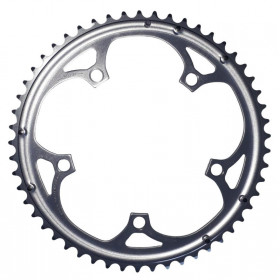 More detailsNew product Out-of-StockCampagnolo 53 teeth chainring 10s 135 mm alu
More detailsNew product Out-of-StockCampagnolo 53 teeth chainring 10s 135 mm alu- €14.90
-
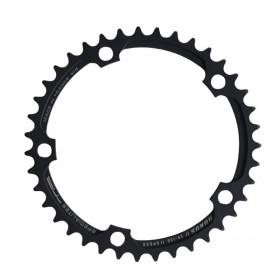 More detailsNew product -20% Out-of-StockChainring 39 teeth TA Horus 11 speed 135 mm
More detailsNew product -20% Out-of-StockChainring 39 teeth TA Horus 11 speed 135 mm- €35.00
- €43.75
-
 More detailsUsed Out-of-StockSram Powerglide chainring 10 speed
More detailsUsed Out-of-StockSram Powerglide chainring 10 speed- €14.99
Showing 1-44 of 44 item(s)
Road bike chainring: how to choose the right one to optimize your drivetrain
The road bike chainring is one of the essential components of a road bike's drivetrain. Attached directly to the bike's crankset, it plays a crucial role in converting pedaling power into speed. For cyclists, whether amateur or experienced, choosing the right road bike chainrings can improve performance, reduce fatigue, and ensure smoother chain shifting.
What is a road bike chainring ?
The chainring is a toothed crown attached to the bike's crankset. The chain engages with this part, allowing the rear wheel to be driven via the cassette. Depending on the number of teeth and the combination of road bike chainrings, the cyclist can adapt their cadence and effort to the terrain (flat, uphill, downhill).
Different chainring configurations for road bikes
There are several types of configurations, depending on the number of chainrings and the number of teeth:
Double chainring (compact or standard)
Compact (50/34 teeth): Ideal for amateurs, cyclosportives, or mountain rides. It allows for easy climbing while maintaining a good cadence.
Standard (53/39 teeth): Designed for more powerful cyclists or competitive racers. It offers a higher top speed, but requires more power when climbing.
Middle chainring (semi-compact)
52/36 teeth: A good compromise between the versatility of a compact chainring and the power of a standard chainring. This configuration is becoming increasingly popular.
Triple chainring
Less common on recent road bikes, but still used by some touring cyclists. It offers a wide range of gears, making it practical for long distances or difficult climbs.
Characteristics of a good road bike chainring
Choosing a road bike chainring that's right for your riding isn't just about the number of teeth. A series of essential technical criteria must be considered to ensure smooth shifting, perfect compatibility with the road bike chain, and good synergy with the rest of the drivetrain.
Number of teeth
The number of teeth determines the gear ratio: that is, the distance traveled with each pedal revolution.
A chainring with many teeth (52, 53) is ideal for riding fast on flat terrain or downhill.
Conversely, a smaller chainring (34, 36 teeth) makes climbing easier thanks to smoother pedaling.
The choice depends on your power, your pedaling cadence, and the terrain of the route.
Material
Most chainrings are made of aluminum, an excellent compromise between lightness, rigidity, and durability. The most demanding cyclists can opt for carbon or titanium/aluminum alloy chainrings, which offer weight savings and increased precision, particularly when changing gears under stress.
Drivetrain and chain compatibility
A good road bike chainring must be perfectly compatible with:
The number of gears in your drivetrain: 10, 11, or 12 speeds. Each standard has a specific chain width. A chainring designed for 12 speeds is thinner and will not work properly with a 10-speed chain, and vice versa.
The road bike chain: It must engage smoothly with the chainring teeth. Some brands machine the teeth to improve the chain's upshifting and downshifting, making gear changes easier.
Front derailleurs: The chainline and chainring diameter must be compatible with the derailleur's movement to avoid friction or chain slippage.
Tip: When changing chainrings, it's often recommended to check the chain and cassette for wear. A consistent set ensures even wear and optimal performance.
Bolt Circle Diameter (BCD)
BCD (Bolt Circle Diameter) refers to the distance between the bolts that attach the chainring to the crankset. There are several standards, the most common being:
130 mm (road standard)
110 mm (compact)
Asymmetrical for certain specific models (e.g., Shimano or SRAM)
A chainring that is not compatible with the bike's crankset will not fit. It is therefore essential to check this before purchasing.
Major road bike chainring brands
Certain brands have established themselves as benchmarks thanks to their manufacturing quality, machining precision, and seamless integration with drivetrains:
Shimano: World leader, their chainrings are designed to work in perfect harmony with their groupsets (105, Ultegra, Dura-Ace). Ultra-smooth gear shifting is guaranteed.
SRAM: Offers lightweight, stiff chainrings compatible with their electronic or mechanical groupsets (Rival, Force, Red).
Campagnolo: Renowned for Italian quality and performance, especially with its Chorus, Record, and Super Record groupsets.
Rotor: Known for its oval chainrings (Q-Rings) that optimize pedaling, especially when climbing. Ideal for experienced cyclists.
Praxis Works, AbsoluteBLACK, or FSA: Alternative brands valued for their innovation, broad compatibility, or specific designs (oval, lightweight, anodized chainrings).
Road bike chainring maintenance
A well-maintained road bike chainring is essential to ensure a smooth drivetrain, limit performance losses, and extend the life of your chain, cassette, and crankset. A worn or dirty chainring can cause chain slips, unexpected derailments, and accelerated wear of the entire drivetrain.
Regular cleaning: the foundation of a high-performance drivetrain
Dirt, sand, dust, and hardened grease act as abrasives that eat away at the chainring teeth. It is therefore crucial to:
Clean the chainring regularly, especially after riding in the rain or on dusty roads.
Use a soft toothbrush or a drivetrain-specific brush to remove debris between the teeth.
Apply a non-corrosive bicycle degreaser to dissolve accumulated grease.
Rinse and dry the chainring thoroughly before re-oiling the chain.
Frequent maintenance (ideally every 2 to 3 outings or after a dirty ride) helps maintain gear shift precision and prevent premature wear of the teeth.
Wear check: telltale signs
The wear of a road bike chainring isn't always visible to the naked eye, but certain warning signs should be noted:
Rounded, wave-shaped, or shark-shaped teeth: These teeth no longer hold the chain properly, causing it to skip or slip.
Deformation or cracks around the attachment points: Increased chainring fragility.
An unusual metallic noise, even with a well-lubricated chain, indicates poor contact between the chain and the teeth.
Repeated chain skipping on certain teeth: This often indicates localized chainring wear.
A specific tool, such as a wear gauge, can be used to check the chain. If it is overstretched, it has probably already damaged the chainrings and cassette.
Smart replacement: together or separately?
It's strongly recommended to replace the chain, cassette, and chainrings simultaneously, especially if you've ridden several thousand kilometers with the same drivetrain. Why?
A new chain on a worn chainring will wear out very quickly, and vice versa.
Mismatched components create a mechanical incompatibility that affects pedaling performance and reliability.
Good to know:
The average lifespan of a chainring is 10,000 to 15,000 km, but this varies depending on your maintenance frequency, your pedaling style, and riding conditions.
The chain, which is subject to more stress, must be replaced more frequently (every 3,000 to 5,000 km depending on use).
A well-maintained drivetrain can operate optimally for longer and reduce replacement costs.
In summary
The road bike chainring is a central link in the bicycle's drivetrain. Choosing the right chainring, based on your riding style and ability, allows you to pedal more efficiently, save energy, and protect your equipment. Whether you ride on flat or mountain roads, road bike chainrings must be in perfect harmony with your pedaling style, your road bike chain, and your crankset.
Related articles:
How and when to change a road bike chainring?
Double or triple chainring for road bikes: which one to choose for your rides?
